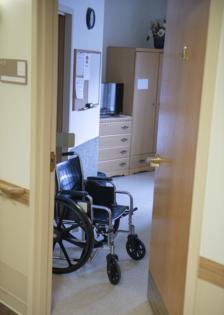Concerns grow over quality of care as investor groups buy not-for-profit nursing homes
Published in Health & Fitness
Shelly Olson’s mother, who has dementia, has lived at the Scandia Village nursing home in rural Sister Bay, Wisconsin, for almost five years. At first, Olson said, her mother received great care at the facility, then owned by a not-for-profit organization, the Evangelical Lutheran Good Samaritan Society.
Then in 2019, Sanford Health — a not-for-profit, tax-exempt hospital system — acquired the nursing home. The COVID-19 pandemic struck soon after. From then on, the facility was regularly short of staff, and residents endured long wait times and other care problems, said Olson, a registered nurse who formerly worked at the facility.
Now Scandia Village has a new, for-profit owner, Continuum Healthcare. Olson said she was reassured when Continuum hired two locals as the facility’s new administrator and nursing director.
But Kathy Wagner, a former Scandia Village nursing director, is not optimistic. “The for-profit owner will face the same problems,” said Wagner, who is now retired and serves on an informal task force that monitors the facility’s quality of care. “No one has articulated what the for-profit owner will bring to the table to change the picture.”
The sale of Scandia Village this year is part of a trend of for-profit companies, including private equity groups and real estate investment trusts, snapping up struggling not-for-profit nursing homes, many of which were operated for decades by Lutheran, Catholic, Jewish, and other faith-based organizations.
The pace of sales has ticked up, reaching a high last year, according to Ziegler Investment Banking. Since 2015, 900 not-for-profit nursing homes and senior living communities nationwide have changed hands, with more than half of them acquired by for-profit operators.
For-profit groups own about 72% of the roughly 15,000 nursing homes in the United States, which serve more than 1.3 million residents.
While overall for-profit ownership percentage hasn’t notably increased in recent years, the type of for-profit companies that own these facilities has shifted toward private equity, real estate investment trusts, and complicated ownership structures, said David Grabowski, a professor of health care policy at Harvard Medical School.
Consumer advocates, researchers, and regulators are leery about this trend. They point to studies showing that nursing homes owned by for-profit companies — particularly investors in private equity and real estate — tend to have skimpier staffing, lower quality ratings, and more regulatory violations. Motivated by these concerns, the Biden administration issued a rule last fall that requires nursing homes to disclose more information about their owners and management firms.
Executives at not-for-profit organizations, as well as researchers who study nursing homes, wonder how for-profit companies can accomplish what the previous not-for-profit owners could not: reviving financially struggling nursing homes.
...continued
©2024 KFF Health News. Distributed by Tribune Content Agency, LLC.







Comments